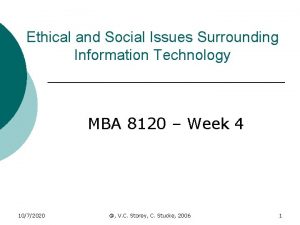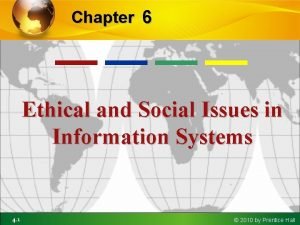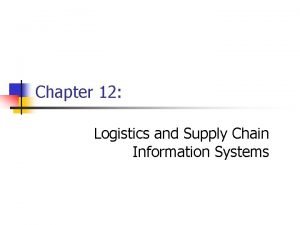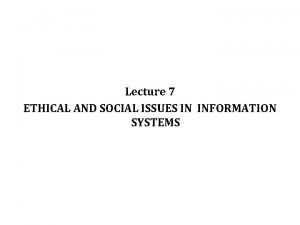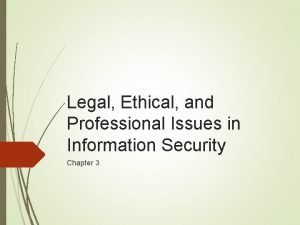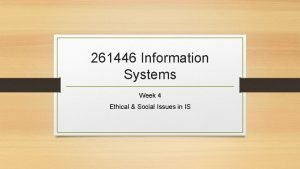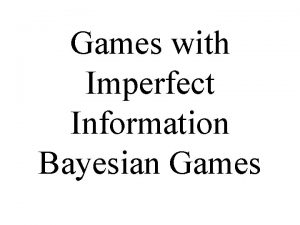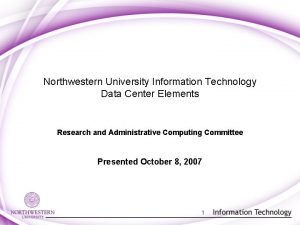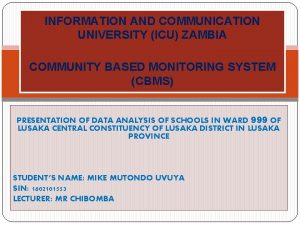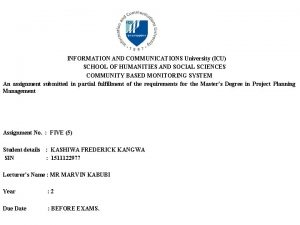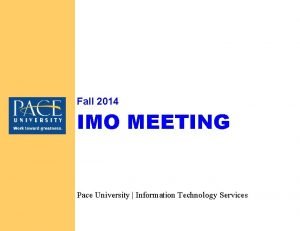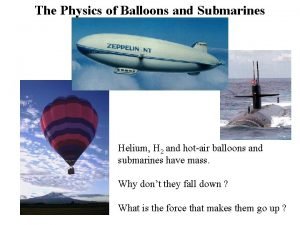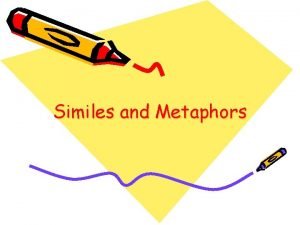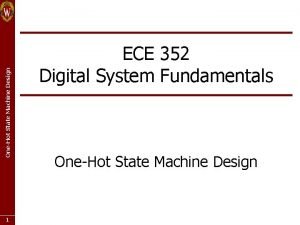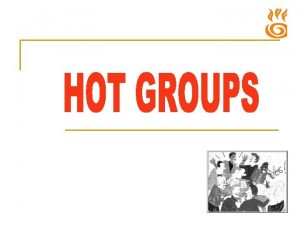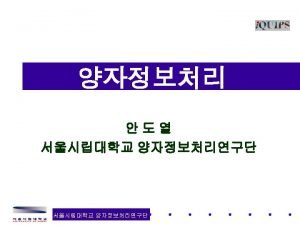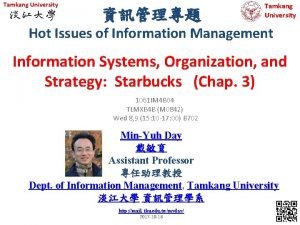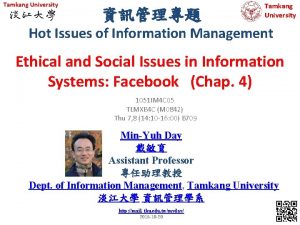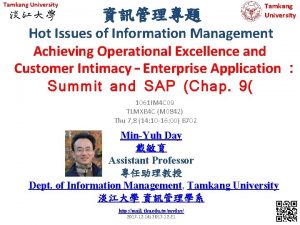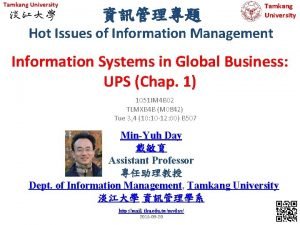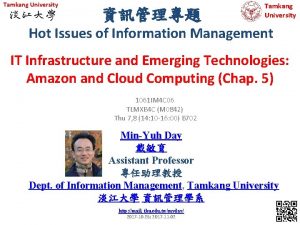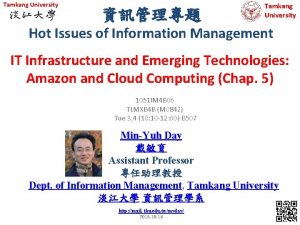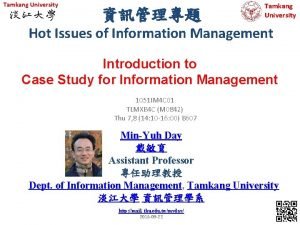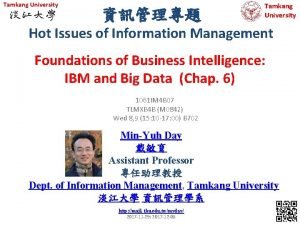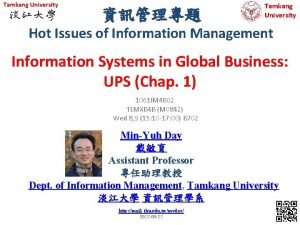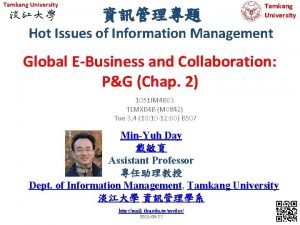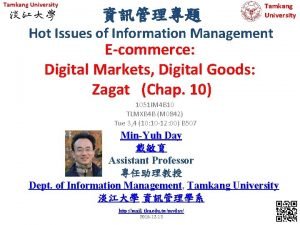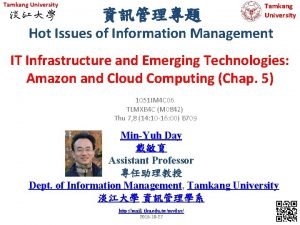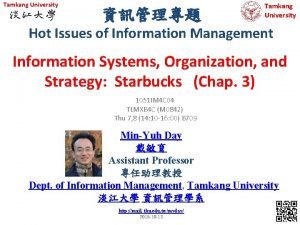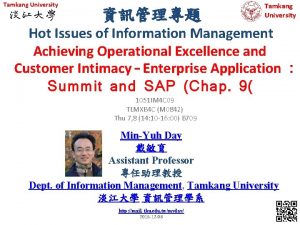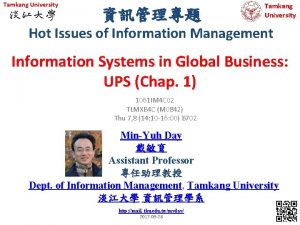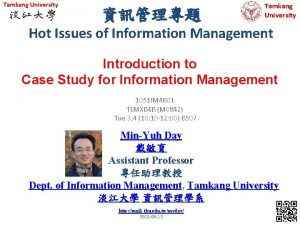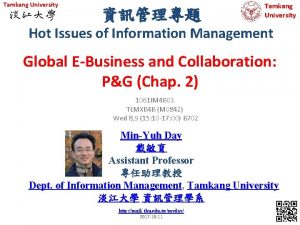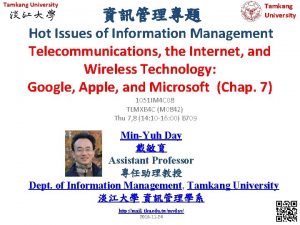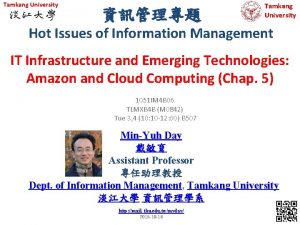Tamkang University Tamkang University Hot Issues of Information


















































- Slides: 50

Tamkang University 資訊管理專題 Tamkang University Hot Issues of Information Management Achieving Operational Excellence and Customer Intimacy – Enterprise Application : Summit and SAP (Chap. 9( 1051 IM 4 B 09 TLMXB 4 B (M 0842) Tue 3, 4 (10: 10 -12: 00) B 507 Min-Yuh Day 戴敏育 Assistant Professor 專任助理教授 Dept. of Information Management, Tamkang University 淡江大學 資訊管理學系 http: //mail. tku. edu. tw/myday/ 2016 -12 -06 1

課程大綱 (Syllabus) 週次 (Week) 日期 (Date) 內容 (Subject/Topics) 1 2016/09/13 Introduction to Case Study for Information Management Hot Topics 2 2016/09/20 Information Systems in Global Business: UPS (Chap. 1) (pp. 53 -54) 3 2016/09/27 Global E-Business and Collaboration: P&G (Chap. 2) (pp. 84 -85) (Typhoon Day Off) 4 2016/10/04 Global E-Business and Collaboration: P&G (Chap. 2) (pp. 84 -85) 5 2016/10/11 Information Systems, Organization, and Strategy: Starbucks (Chap. 3) (pp. 129 -130) 2

課程大綱 (Syllabus) 週次 (Week) 日期 (Date) 內容 (Subject/Topics) 6 2016/10/18 Ethical and Social Issues in Information Systems: Facebook (Chap. 4) (pp. 188 -190) 7 2016/10/25 IT Infrastructure and Emerging Technologies: Amazon and Cloud Computing (Chap. 5) (pp. 234236) 8 2016/11/01 IT Infrastructure and Emerging Technologies: Amazon and Cloud Computing (Chap. 5) (pp. 234236) 9 2016/11/08 Foundations of Business Intelligence: IBM and Big Data (Chap. 6) (pp. 261 -262) 10 2016/11/15 期中考試週 11 2016/11/22 Midterm Report (期中報告) 3

課程大綱 (Syllabus) 週次 日期 內容(Subject/Topics) 12 2016/11/29 Telecommunications, the Internet, and Wireless Technology: Google, Apple, and Microsoft (Chap. 7) (pp. 318 -320) 13 2016/12/06 Enterprise Applications: Summit and SAP (Chap. 9) (pp. 396 -398) 14 2016/12/13 E-commerce: Zagat (Chap. 10) (pp. 443 -445) 15 2016/12/20 Enhancing Decision Making: Zynga (Chap. 12) (pp. 512 -514) 16 2016/12/27 Final Report I (期末報告 I) 17 2017/01/03 Final Report II (期末報告 II) 18 2017/01/10 期末考試週 4

Management Information Systems: Managing the Digital Firm 1 2 3 4 Organization, Management, and the Networked Enterprise Information Technology Infrastructure Key System Applications for the Digital Age Building and Managing Systems Source: Kenneth C. Laudon & Jane P. Laudon (2014), Management Information Systems: Managing the Digital Firm, Thirteenth Edition, Pearson. 5

Chap. 9 Achieving Operational Excellence and Customer Intimacy – Enterprise Application: Summit and SAP 6

Case Study: Summit and SAP (Chap. 9) (pp. 396 -398) Summit Electric Lights Up with a New ERP System 1. Which business processes are the most important at Summit Electric Supply? Why? 2. What problems did Summit have with its old systems? What was the business impact of those problems? 3. How did Summit’s ERP system improve operational efficiency and decision making? Give several examples. 4. Describe two ways in which Summit’s customers benefit from the new ERP system. 5. Diagram Summit’s old and new process for handling chargebacks. Source: Kenneth C. Laudon & Jane P. Laudon (2014), Management Information Systems: Managing the Digital Firm, Thirteenth Edition, Pearson. 7

Overview of Fundamental MIS Concepts Business Challenges Management Organization Information System Business Solutions Technology Source: Kenneth C. Laudon & Jane P. Laudon (2014), Management Information Systems: Managing the Digital Firm, Thirteenth Edition, Pearson. 8

Business Model 8 6 2 4 Key Activities Key Partners 7 Customer Relationships Value Proposition Key Resources 9 Cost Structure 1 Customer Segments 3 Channels 5 Revenue Streams Source: Alexander Osterwalder & Yves Pigneur, Business Model Generation: A Handbook for Visionaries, Game Changers, and Challengers, Wiley, 2010. 9

Definition of Business Model A business model describes the rationale of how an organization creates, delivers, and captures value. Source: Alexander Osterwalder & Yves Pigneur, Business Model Generation: A Handbook for Visionaries, Game Changers, and Challengers, Wiley, 2010. 10

Definition of Business Strategy A business strategy is a long term plan of action designed to achieve a particular goal or set of goals or objectives. Source: (Ostenwalder, Pigneur and Tucci, 2005) 11

Objectives 12

Business Objectives 13

Strategic Business Objectives of Information Systems 14

Strategic Business Objectives of Information Systems 1. 2. 3. 4. 5. 6. Operational Excellence New Products, Services and Business Models Customer and Supplier Intimacy Improved Decision Making Competitive Advantage Survival Source: Kenneth C. Laudon & Jane P. Laudon (2014), Management Information Systems: Managing the Digital Firm, Thirteenth Edition, Pearson. 15

Chap. 9 Achieving Operational Excellence and Customer Intimacy – Enterprise Application Source: Kenneth C. Laudon & Jane P. Laudon (2014), Management Information Systems: Managing the Digital Firm, Thirteenth Edition, Pearson. 16

The Interdependence Between Organizations and Information Technology Source: Kenneth C. Laudon & Jane P. Laudon (2014), Management Information Systems: Managing the Digital Firm, Thirteenth Edition, Pearson. 17

Business Processes • Business processes: – the set of logically related tasks and behaviors that organizations develop over time to produce specific business results and the unique manner in which these activities are organized and coordinated. • Business processes: – the manner in which work is organized, coordinated, and focused to produce a valuable product or service. • Business processes are the collection of activities required to produce a product or service. Source: Kenneth C. Laudon & Jane P. Laudon (2014), Management Information Systems: Managing the Digital Firm, Thirteenth Edition, Pearson. 18

Enterprise Systems • Enterprise resource planning (ERP) systems • Suite of integrated software modules and a common central database • Collects data from many divisions of firm for use in nearly all of firm’s internal business activities • Information entered in one process is immediately available for other processes Source: Kenneth C. Laudon & Jane P. Laudon (2014), Management Information Systems: Managing the Digital Firm, Thirteenth Edition, Pearson. 19

Enterprise Software • Built around thousands of predefined business processes that reflect best practices – – Finance and accounting: General ledger, accounts payable, etc. Human resources: Personnel administration, payroll, etc. Manufacturing and production: Purchasing, shipping, etc. Sales and marketing: Order processing, billing, sales planning, etc. • To implement, firms: – Select functions of system they wish to use – Map business processes to software processes • Use software’s configuration tables for customizing Source: Kenneth C. Laudon & Jane P. Laudon (2014), Management Information Systems: Managing the Digital Firm, Thirteenth Edition, Pearson. 20

How Enterprise Systems Work Source: Kenneth C. Laudon & Jane P. Laudon (2014), Management Information Systems: Managing the Digital Firm, Thirteenth Edition, Pearson. 21

Business Value of Enterprise Systems • Increase operational efficiency • Provide firm-wide information to support decision making • Enable rapid responses to customer requests for information or products • Include analytical tools to evaluate overall organizational performance Source: Kenneth C. Laudon & Jane P. Laudon (2014), Management Information Systems: Managing the Digital Firm, Thirteenth Edition, Pearson. 22

Supply Chain Management Systems • Supply Chain – Network of organizations and processes for: • Procuring materials, transforming them into products, and distributing the products – Upstream supply chain: • Firm’s suppliers, suppliers’ suppliers, processes for managing relationships with them – Downstream supply chain: • Organizations and processes responsible for delivering products to customers – Internal supply chain Source: Kenneth C. Laudon & Jane P. Laudon (2014), Management Information Systems: Managing the Digital Firm, Thirteenth Edition, Pearson. 23

Supply Chain Management Systems: Nike’s Supply Chain Source: Kenneth C. Laudon & Jane P. Laudon (2014), Management Information Systems: Managing the Digital Firm, Thirteenth Edition, Pearson. 24

Supply Chain Management Systems • Supply Chain Management (SCM) – Inefficiencies cut into a company’s operating costs • Can waste up to 25% of operating expenses – Just-in-time strategy: • Components arrive as they are needed • Finished goods shipped after leaving assembly line – Safety stock: Buffer for lack of flexibility in supply chain – Bullwhip effect • Information about product demand gets distorted as it passes from one entity to next across supply chain Source: Kenneth C. Laudon & Jane P. Laudon (2014), Management Information Systems: Managing the Digital Firm, Thirteenth Edition, Pearson. 25

Supply Chain Management Systems: The Bullwhip Effect Source: Kenneth C. Laudon & Jane P. Laudon (2014), Management Information Systems: Managing the Digital Firm, Thirteenth Edition, Pearson. 26

Supply Chain Management Software • Supply chain planning systems – Model existing supply chain – Enable demand planning – Optimize sourcing, manufacturing plans – Establish inventory levels – Identify transportation modes • Supply chain execution systems – Manage flow of products through distribution centers and warehouses Source: Kenneth C. Laudon & Jane P. Laudon (2014), Management Information Systems: Managing the Digital Firm, Thirteenth Edition, Pearson. 27

Global Supply Chain Issues • Greater geographical distances • Greater time differences • Participants from different countries – Different performance standards – Different legal requirements Source: Kenneth C. Laudon & Jane P. Laudon (2014), Management Information Systems: Managing the Digital Firm, Thirteenth Edition, Pearson. 28

Internet Helps Manage Global Complexities • • Warehouse management Transportation management Logistics Outsourcing Source: Kenneth C. Laudon & Jane P. Laudon (2014), Management Information Systems: Managing the Digital Firm, Thirteenth Edition, Pearson. 29

Supply Chain Management • Push-based model (build-to-stock) – Earlier SCM systems – Schedules based on best guesses of demand • Pull-based model (demand-driven) – Web-based – Customer orders trigger events in supply chain • Internet enables move from sequential supply chains to concurrent supply chains – Complex networks of suppliers can adjust immediately Source: Kenneth C. Laudon & Jane P. Laudon (2014), Management Information Systems: Managing the Digital Firm, Thirteenth Edition, Pearson. 30

Push- Versus Pull-Based Supply Chain Models Source: Kenneth C. Laudon & Jane P. Laudon (2014), Management Information Systems: Managing the Digital Firm, Thirteenth Edition, Pearson. 31

The Future Internet-Driven Supply Chain Source: Kenneth C. Laudon & Jane P. Laudon (2014), Management Information Systems: Managing the Digital Firm, Thirteenth Edition, Pearson. 32

Business Value of SCM Systems Match supply to demand; reduce inventory levels Improve delivery service Speed product time to market Use assets more effectively Reduced supply chain costs lead to increased profitability – Total supply chain costs can be 75% of operating budget • Increase sales • • • Source: Kenneth C. Laudon & Jane P. Laudon (2014), Management Information Systems: Managing the Digital Firm, Thirteenth Edition, Pearson. 33

Customer Relationship Management Systems • Customer relationship management (CRM) – Knowing the customer – In large businesses, too many customers and too many ways customers interact with firm • CRM systems: – Capture and integrate customer data from all over the organization – Consolidate and analyze customer data – Distribute customer information to various systems and customer touch points across enterprise – Provide single enterprise view of customers Source: Kenneth C. Laudon & Jane P. Laudon (2014), Management Information Systems: Managing the Digital Firm, Thirteenth Edition, Pearson. 34

Customer Relationship Management (CRM) Source: Kenneth C. Laudon & Jane P. Laudon (2014), Management Information Systems: Managing the Digital Firm, Thirteenth Edition, Pearson. 35

CRM Software • Packages range from niche tools to large-scale enterprise applications. • More comprehensive have modules for: – Partner relationship management (PRM) • Integrating lead generation, pricing, promotions, order configurations, and availability • Tools to assess partners’ performances – Employee relationship management (ERM) • Setting objectives, employee performance management, performance-based compensation, employee training Source: Kenneth C. Laudon & Jane P. Laudon (2014), Management Information Systems: Managing the Digital Firm, Thirteenth Edition, Pearson. 36

CRM packages typically include tools for • Sales force automation (SFA) – Sales prospect and contact information, sales quote generation capabilities • Customer service – Assigning and managing customer service requests, Web-based self-service capabilities • Marketing – Capturing prospect and customer data, scheduling and tracking direct-marketing mailings or e-mail, cross-selling Source: Kenneth C. Laudon & Jane P. Laudon (2014), Management Information Systems: Managing the Digital Firm, Thirteenth Edition, Pearson. 37

How CRM Systems Support Marketing Source: Kenneth C. Laudon & Jane P. Laudon (2014), Management Information Systems: Managing the Digital Firm, Thirteenth Edition, Pearson. 38

CRM Software Capabilities Source: Kenneth C. Laudon & Jane P. Laudon (2014), Management Information Systems: Managing the Digital Firm, Thirteenth Edition, Pearson. 39

Customer Loyalty Management Process Map Source: Kenneth C. Laudon & Jane P. Laudon (2014), Management Information Systems: Managing the Digital Firm, Thirteenth Edition, Pearson. 40

Customer Relationship Management Systems • Operational CRM: – Customer-facing applications such as sales force automation, call center and customer service support, and marketing automation • Analytical CRM: – Based on data warehouses populated by operational CRM systems and customer touch points – Analyzes customer data (OLAP, data mining, etc. ) • Customer lifetime value (CLTV) Source: Kenneth C. Laudon & Jane P. Laudon (2014), Management Information Systems: Managing the Digital Firm, Thirteenth Edition, Pearson. 41

Analytical CRM Data Warehouse Source: Kenneth C. Laudon & Jane P. Laudon (2014), Management Information Systems: Managing the Digital Firm, Thirteenth Edition, Pearson. 42

Business Value of CRM Systems • • • Increased customer satisfaction Reduced direct-marketing costs More effective marketing Lower costs for customer acquisition/retention Increased sales revenue Source: Kenneth C. Laudon & Jane P. Laudon (2014), Management Information Systems: Managing the Digital Firm, Thirteenth Edition, Pearson. 43

Churn Rate • Number of customers who stop using or purchasing products or services from a company • Indicator of growth or decline of firm’s customer base Source: Kenneth C. Laudon & Jane P. Laudon (2014), Management Information Systems: Managing the Digital Firm, Thirteenth Edition, Pearson. 44

Enterprise Applications: New Opportunities and Challenges • Enterprise application challenges – Highly expensive to purchase and implement enterprise applications • Average “large” system—$12 million + • Average “small/midsize” system—$3. 5 million – Technology changes – Business process changes – Organizational learning, changes – Switching costs, dependence on software vendors – Data standardization, management, cleansing Source: Kenneth C. Laudon & Jane P. Laudon (2014), Management Information Systems: Managing the Digital Firm, Thirteenth Edition, Pearson. 45

Next-Generation Enterprise Applications • Enterprise solutions/suites: – Make applications more flexible, Web-enabled, integrated with other systems • • • SOA standards Open-source applications On-demand solutions Cloud-based versions Functionality for mobile platform Source: Kenneth C. Laudon & Jane P. Laudon (2014), Management Information Systems: Managing the Digital Firm, Thirteenth Edition, Pearson. 46

Next-Generation Enterprise Applications • Social CRM – Incorporating social networking technologies – Company social networks – Customer interaction via Facebook – For example: Buzzient platform integrates social media with enterprise applications • Business intelligence – Inclusion of BI with enterprise applications – Flexible reporting, ad hoc analysis, “what-if” scenarios, digital dashboards, data visualization Source: Kenneth C. Laudon & Jane P. Laudon (2014), Management Information Systems: Managing the Digital Firm, Thirteenth Edition, Pearson. 47

Case Study: E-commerce: Zagat (Chap. 10) (pp. 443 -445) To Pay or Not to Pay: Zagat’s Dilemma 1. Evaluate Zagat using the competitive forces and value chain models. 2. Compare Zagat’s and Yelp’s e-commerce business models. How have those models affected each company's Web strategy? 3. Why was Zagat’s content well suited for the Web and for the mobile digital platform? 4. Do you think Zagat’s decision to use a pay wall for its Web site was a mistake? Why or why not? 5. Will Zagat’s acquisition by Google make it more competitive? Explain your answer. Source: Kenneth C. Laudon & Jane P. Laudon (2014), Management Information Systems: Managing the Digital Firm, Thirteenth Edition, Pearson. 48


References – Kenneth C. Laudon & Jane P. Laudon (2014), Management Information Systems: Managing the Digital Firm, Thirteenth Edition, Pearson. – Kenneth C. Laudon & Jane P. Laudon原著, 游張松 主編,陳文生 翻譯 (2014), 資訊管理系統,第 13版,滄海 50
 White hot vs red hot temperature
White hot vs red hot temperature Hot working of metals is carried out
Hot working of metals is carried out Perbedaan hot lava dan hot lava volcano
Perbedaan hot lava dan hot lava volcano Hot nor
Hot nor Legal and ethical issues in computer security
Legal and ethical issues in computer security Issues surrounding information privacy
Issues surrounding information privacy Issues in information systems
Issues in information systems Ethical and social issues in information system
Ethical and social issues in information system Legal ethical and societal issues
Legal ethical and societal issues Chapter 4 ethical issues
Chapter 4 ethical issues Contemporary issues in information systems
Contemporary issues in information systems Information about social issues
Information about social issues Social issues in technology management
Social issues in technology management Legal and ethical issues in information security
Legal and ethical issues in information security 4 components of an information system
4 components of an information system Ethical and social issues in information systems
Ethical and social issues in information systems Incomplete information vs imperfect information
Incomplete information vs imperfect information Northwestern university information technology
Northwestern university information technology Icu zambia assignments
Icu zambia assignments Tashkent university of information technology
Tashkent university of information technology Department of information engineering university of padova
Department of information engineering university of padova Information engineering padova
Information engineering padova List of lecturers at icu zambia
List of lecturers at icu zambia Pace university information technology
Pace university information technology 沈榮麟
沈榮麟 Hotpack endikasyonları
Hotpack endikasyonları Xxxxx6
Xxxxx6 Simple diagram of hot air oven
Simple diagram of hot air oven Why is las vegas so hot
Why is las vegas so hot Storing sandwiches
Storing sandwiches Osha hot work
Osha hot work Diferencia entre coil y visbreaker de inmersión
Diferencia entre coil y visbreaker de inmersión Erdes hot
Erdes hot What keeps the sun hot
What keeps the sun hot Balloons
Balloons A hot summer day fox and goat story
A hot summer day fox and goat story Message hot oil
Message hot oil Japanese game show hot
Japanese game show hot Solar hot dog cooker
Solar hot dog cooker Brianna jordan hot
Brianna jordan hot How hot are stars
How hot are stars Summer poems with figurative language
Summer poems with figurative language Cold war hot spots
Cold war hot spots Words with the root viv
Words with the root viv Psych weakness
Psych weakness Preparing desserts ppt
Preparing desserts ppt February ted hughes analysis
February ted hughes analysis One hot state machine
One hot state machine Hot group
Hot group Given δpqr and δstu, what is m∠q?
Given δpqr and δstu, what is m∠q? Hot carrier 효과
Hot carrier 효과





